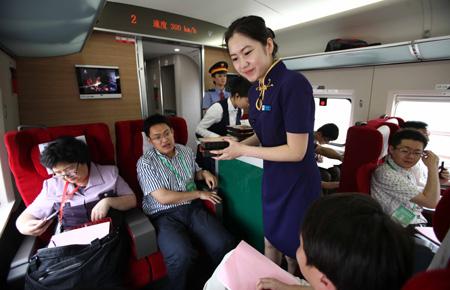
A train attendant delivers food to media delegates who are aboard a Beijing-Shanghai high-speed train for a personal experience on Friday. [Photo/China Daily]
When I was thinking of what dateline to use for this story, I hesitated, because I left Beijing for Shanghai and returned to Beijing in a day. Solution: no dateline.
Before the completion of the Beijing-Shanghai high-speed railway, that could happen only on an airplane and only when the weather cooperated. Now, 10 hours is the travel time for a round-trip by railroad between China's two biggest cities.
On Friday, some 100 media delegates made the trip aboard a bullet train that ran at 300 km/h all along the way.
The journey started from Beijing South Railway Station, where all of us gathered to board the G1 train that leaves for Shanghai at 9:10 am.
When we descended to the platform on an escalator, I saw several white tube-like trains waiting side by side for passengers.
This is totally different from what I saw on my first visit to Beijing South when it opened in 2008. Then, the platform looked spacious and empty, with only one or two bullet trains in sight, because only trains running on the Beijing-Tianjin intercity railway used that station.
From the outside, our train seemed no different from others, except that it was coded as CRH380AL, indicating its top designed speed is 380 km/h. But inside, it had many surprises.
The new train contains a cabin for business-class passengers with 24 seats that resemble those in a plane's business class, although these can revolve.
A passenger can lie flat to rest on the leather-covered seat, or can watch entertainment on a small screen, choosing a program by touching the screen.
It is said that each seat in the business cabin costs more than 100,000 yuan ($15,000). No wonder the Ministry of Railways sets the price for a business seat at 1,750 yuan. A second-class seat on the same train costs only 555 yuan.
There also are two business-class seats at each end of the train, next to the driver's room. Passengers there can look through a glass wall and see what the driver sees.
If the passengers want to, however, they can press a button that turns the glass wall opaque. A reporter who knows cars told me that a similar device is available in a luxury automobile made by Rolls-Royce.
Because there is no business class in the previous bullet trains, almost all of the reporters' eyes - and their bodies - were attracted to them. The buzzing of seats changing positions lasted all the way.
Many of my fellow passengers had not noticed that the train had sped from zero to 300 km/h in just four minutes. We raced past monotonous views of green and golden patches of farmland.
"The Beijing-Shanghai high-speed railway is laid upon a large plain on the eastern part of the country, which is a major crop production base," said Ma Yunshuang, deputy president and technology director of CSR Qingdao Sifang Co Ltd, which designs and manufactures the train. "In comparison, the view along the Wuhan-Guangzhou high-speed railway is much better with those mountains and rivers."
The view provided a small surprise near the end of the trip after the train passed Nanjing around 12:50 pm and entered Jiangsu province. A typical panorama of the area south to the Yangtze River scrolled out in front of me.
Two-story buildings with white walls and gray roofs stood between green farmland and trees, with ponds dotted here and there - all gauzed in a foggy drizzle.
I felt that I was wandering through a traditional Chinese painting. It is something available only by riding in the high-speed train, a "land flight".
One thing may disappoint frequent air travelers, especially those who fly business class.
The food is served in a single-use plastic container with a plastic seal that is hard to tear open. And it comes with a paper cup of instant soup and a pair of bamboo chopsticks, instead of a fork-knife-spoon set.
If the railway authority wants to grab more travelers from airlines, it needs to work on that.





